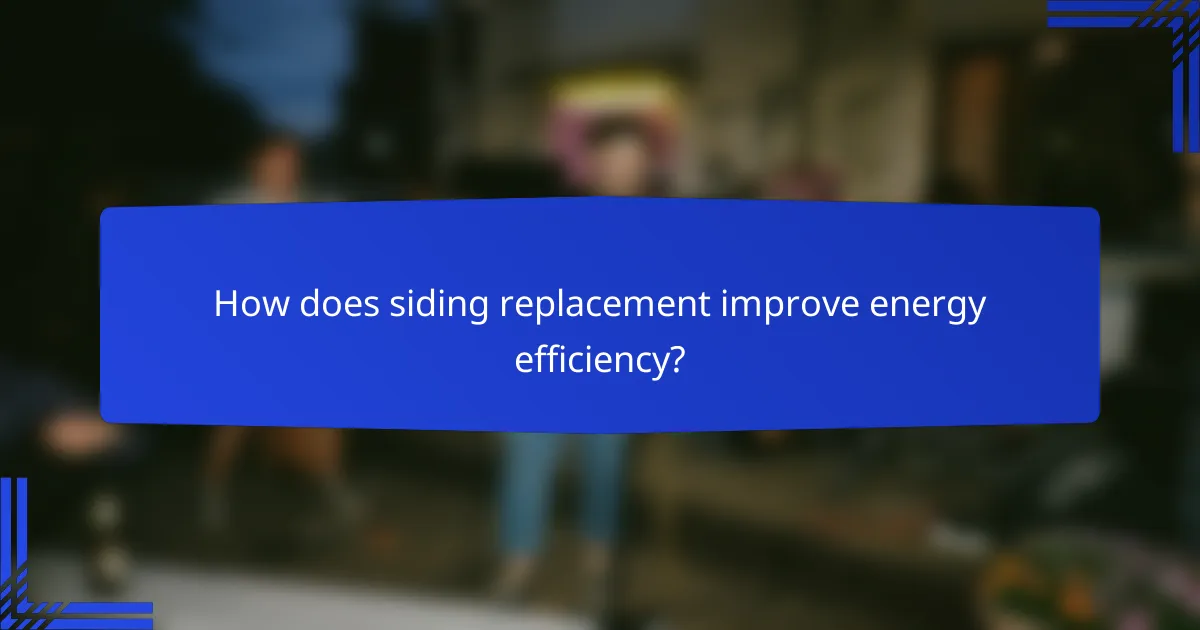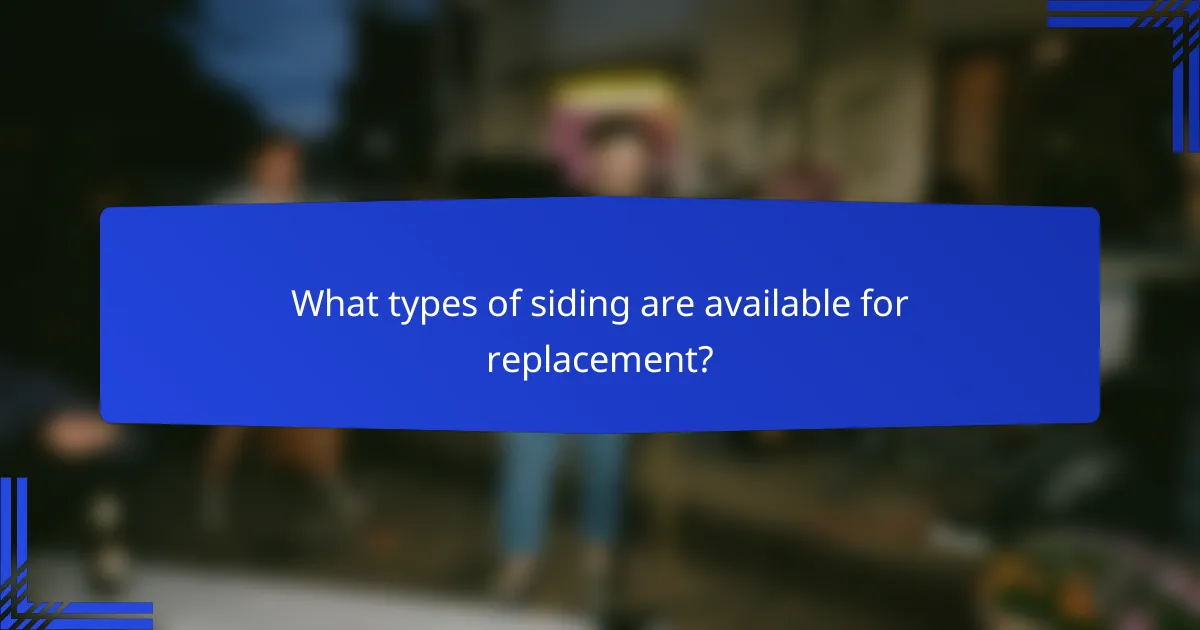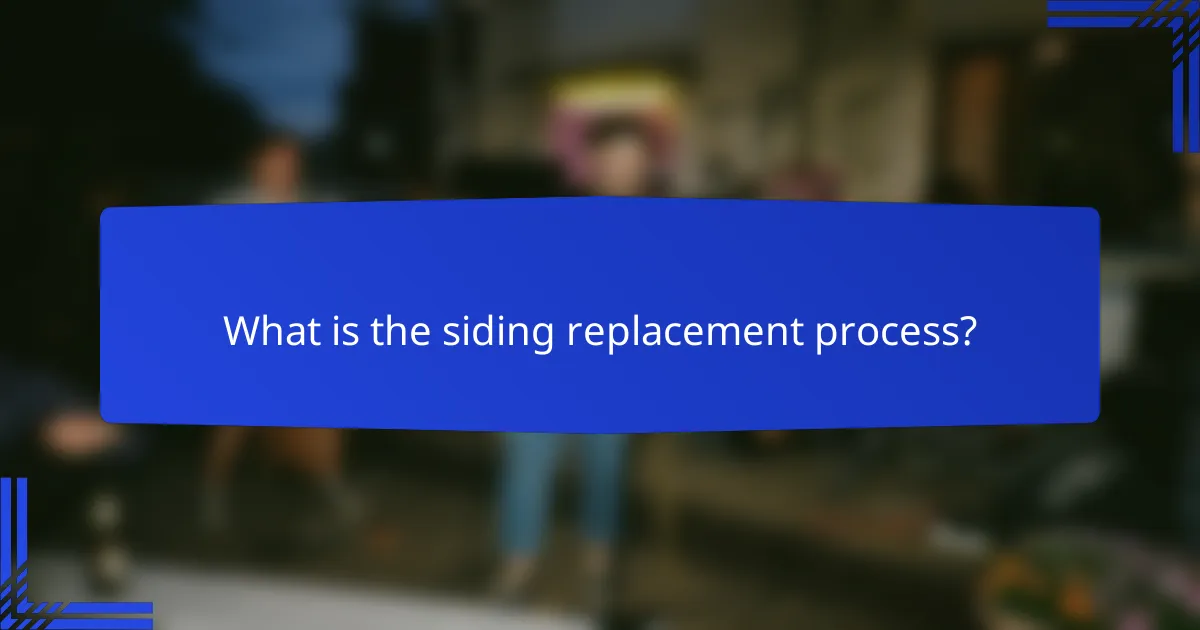Siding replacement is a valuable investment for homeowners, providing enhanced weather protection, a fresh aesthetic upgrade, and lower maintenance requirements. By choosing modern materials, you can improve your home’s durability and energy efficiency while also boosting its curb appeal and potentially increasing its market value.

What are the benefits of siding replacement in the UK?
Siding replacement in the UK offers significant advantages, including improved weather protection, enhanced aesthetics, and reduced maintenance needs. These benefits contribute to a more durable and visually appealing home while potentially increasing property value.
Enhanced weather protection
New siding provides better insulation and shields your home from harsh weather conditions, such as rain, wind, and temperature fluctuations. Materials like vinyl, fiber cement, and wood can help prevent moisture infiltration, which is crucial in the UK’s often damp climate.
When selecting siding, consider options with high durability ratings and weather resistance. Look for products that meet UK standards for thermal performance, as this can lead to lower energy bills and a more comfortable living environment.
Aesthetic upgrade options
Siding replacement allows homeowners to choose from a wide range of styles, colors, and textures, enhancing the overall appearance of their property. Options like clapboard, shingles, or modern panels can transform the look of your home, making it more attractive to potential buyers.
Consider local architectural styles when selecting siding to ensure it complements your neighborhood. Investing in high-quality materials can also provide a lasting aesthetic appeal, reducing the need for frequent updates or repairs.
Low maintenance materials
Many modern siding materials require minimal upkeep, making them an attractive choice for busy homeowners. For instance, vinyl siding is resistant to fading, peeling, and cracking, while fiber cement can withstand pests and rot.
When choosing siding, look for options that come with warranties and are designed for longevity. Regular inspections and occasional cleaning can help maintain their appearance, but overall, low-maintenance materials can save time and money in the long run.

How does siding replacement improve energy efficiency?
Siding replacement enhances energy efficiency by providing better insulation and reducing air leakage, which keeps homes warmer in winter and cooler in summer. Modern materials are designed to meet or exceed energy standards, ensuring optimal thermal performance.
Insulation properties of modern siding
Modern siding materials, such as insulated vinyl or fiber cement, offer superior insulation properties compared to older options. These materials often include built-in insulation or can be paired with insulation boards to enhance thermal resistance.
When selecting siding, look for products with high R-values, which indicate better insulation performance. This can significantly reduce the amount of energy needed for heating and cooling, contributing to lower utility bills.
Reduction in heating and cooling costs
Replacing siding can lead to noticeable reductions in heating and cooling costs, often by 10-20% depending on the existing condition of the home and the materials used. Improved insulation and reduced air infiltration help maintain consistent indoor temperatures.
Homeowners should consider the long-term savings when investing in new siding. While the initial cost may be significant, the energy savings over time can offset the expense, making it a financially sound decision. Regular maintenance of the siding can further enhance its efficiency and lifespan.

What types of siding are available for replacement?
When considering siding replacement, homeowners have several options, each offering unique benefits and aesthetics. The most common types include vinyl, wood, and fiber cement siding, each varying in durability, maintenance, and cost.
Vinyl siding options
Vinyl siding is a popular choice due to its affordability and low maintenance requirements. It comes in a variety of colors and styles, including traditional lap, vertical, and shake designs, allowing homeowners to achieve their desired look.
When selecting vinyl siding, consider thickness and insulation properties, as these can affect durability and energy efficiency. Standard costs typically range from $2 to $7 per square foot, depending on the quality and style chosen.
Wood siding choices
Wood siding offers a classic and natural aesthetic, appealing to those who appreciate traditional architecture. Common types include cedar, pine, and redwood, each providing unique grain patterns and colors.
While wood siding can enhance curb appeal, it requires regular maintenance, such as painting or staining, to prevent rot and insect damage. Budgeting for wood siding typically ranges from $3 to $10 per square foot, depending on the type of wood and finish.
Fiber cement siding benefits
Fiber cement siding combines the best features of wood and vinyl, offering durability and low maintenance. It is resistant to rot, fire, and pests, making it a long-lasting option for homeowners.
Available in various styles, including lap, panel, and board-and-batten, fiber cement can mimic the appearance of wood or stucco. Costs generally range from $5 to $12 per square foot, reflecting its robust performance and aesthetic versatility.

How to choose the right siding for your home?
Choosing the right siding for your home involves considering factors such as climate, aesthetics, and maintenance needs. The ideal siding will protect your home from weather elements while enhancing its visual appeal and requiring minimal upkeep.
Factors to consider: climate and aesthetics
When selecting siding, evaluate your local climate and the desired aesthetic. For instance, homes in areas with heavy rainfall may benefit from materials like vinyl or fiber cement, which resist moisture and rot. In contrast, regions with extreme sun exposure might require UV-resistant options to prevent fading.
Aesthetics play a crucial role in your choice as well. Consider the architectural style of your home and the neighborhood’s character. Options like wood siding provide a classic look, while metal or vinyl can offer a modern appearance. Choose colors and textures that complement your home’s design.
Cost comparison of materials
The cost of siding materials varies significantly, impacting your overall budget. Vinyl siding typically ranges from $2 to $7 per square foot, making it a cost-effective choice. Fiber cement may cost between $5 and $10 per square foot, offering durability and low maintenance.
Wood siding can be more expensive, often ranging from $6 to $12 per square foot, but it provides a natural aesthetic. Metal siding, while durable, can also be on the higher end, around $7 to $15 per square foot. Factor in installation costs, which can add another $1 to $3 per square foot, depending on the material and complexity of the job.

What is the siding replacement process?
The siding replacement process involves assessing the current siding, selecting new materials, and installing them properly. This ensures improved weather protection, an aesthetic upgrade, and low maintenance for your home.
Step 1: Assessment of current siding
The first step in siding replacement is to evaluate the existing siding for damage, wear, or inefficiency. Look for signs such as cracks, warping, or moisture infiltration, which can indicate that replacement is necessary.
Consider the age of the siding as well; materials like wood may require replacement sooner than vinyl or fiber cement. Document any issues to inform your choice of new materials.
Step 2: Selecting new siding materials
Choosing the right siding materials is crucial for achieving the desired look and functionality. Options include vinyl, wood, fiber cement, and metal, each offering different benefits in terms of durability, maintenance, and aesthetics.
For instance, vinyl is low-maintenance and cost-effective, while fiber cement offers superior durability and fire resistance. Compare the long-term costs and benefits of each material to make an informed decision.
Step 3: Installation procedures
Proper installation is key to ensuring the longevity and performance of your new siding. Begin by removing the old siding and preparing the surface, which may involve repairs to the underlying structure.
Follow the manufacturer’s guidelines for installation, which typically include securing the panels, ensuring proper overlap, and sealing edges to prevent moisture intrusion. Hiring a professional can help avoid common pitfalls and ensure compliance with local building codes.

What are the costs associated with siding replacement?
The costs of siding replacement can vary significantly based on materials, labor, and location. Homeowners should expect to spend anywhere from a few thousand to over ten thousand pounds, depending on the scope of the project.
Average costs in the UK
In the UK, the average cost for siding replacement typically ranges from £4,000 to £10,000. Vinyl siding tends to be on the lower end of this spectrum, while premium materials like wood or fiber cement can push costs higher.
Additionally, the size of the home and the complexity of the installation can affect the final price. For instance, larger homes or those requiring extensive prep work may incur additional expenses.
Factors influencing pricing
Several factors can influence the pricing of siding replacement, including the type of material chosen, labor costs in the area, and any necessary repairs to the underlying structure. For example, vinyl siding is generally more affordable compared to wood or stone options.
Labor costs can vary by region, with urban areas typically charging more than rural locations. Homeowners should also consider potential additional costs for insulation or moisture barriers, which can enhance energy efficiency but add to the overall expense.

How to maintain new siding?
Maintaining new siding is essential for preserving its appearance and functionality. Regular inspections, cleaning, and timely repairs will help extend its lifespan and protect your investment.
Regular inspections
Conduct regular inspections of your siding at least twice a year, ideally in spring and fall. Look for signs of damage, such as cracks, warping, or discoloration. Early detection of issues can prevent more extensive repairs later.
Pay special attention to areas around windows, doors, and at the base of the siding where moisture can accumulate. If you notice any problems, address them promptly to maintain the integrity of your siding.
Cleaning techniques
Cleaning your siding is crucial for maintaining its aesthetic appeal and preventing mold or mildew growth. Use a soft-bristle brush or a pressure washer set to a low setting to remove dirt and debris. For tougher stains, a mixture of water and mild detergent can be effective.
Avoid harsh chemicals that could damage the siding material. For wood siding, consider using a wood-safe cleaner to preserve its finish. Aim to clean your siding at least once a year to keep it looking fresh.
Repairing damages
Timely repairs are vital to prevent small issues from escalating. For minor cracks or holes, use caulk or a suitable patching compound to seal them. For more significant damage, such as rotting wood or extensive cracks, replacement of the affected panels may be necessary.
Always follow the manufacturer’s guidelines for repairs to ensure compatibility with your siding material. Keeping a small supply of matching siding on hand can make repairs easier and maintain a uniform appearance.
